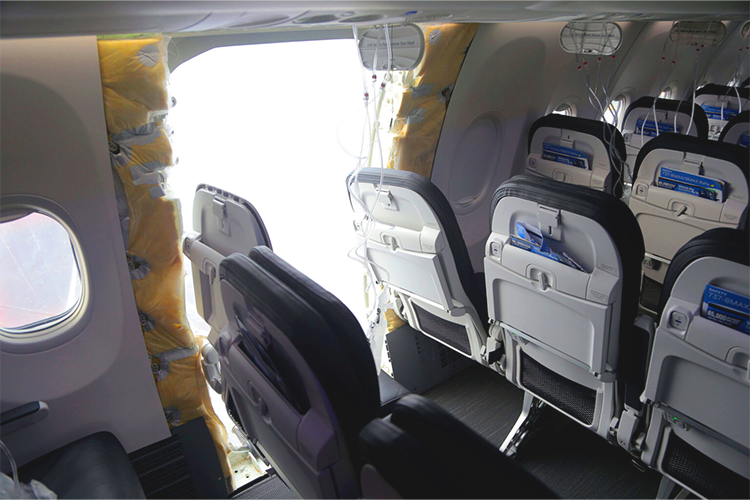
The aftermath of the Alaska Airlines results in many consequences for Boeing. photo by the National Transportation Safety Board
In January of 2024, Alaska Airlines flight 1282 resorted to an in-flight emergency landing.
Alaska Airlines, one of the most popular airlines in the United States, was forced to ground dozens of Boeing 737-9 Max planes due to a midair emergency that occurred on January 5, 2024. The emergency occurred around six minutes after take-off when a door panel fell off of the plane. Zero bolts had been installed on the door plug—a careless mistake that left Boeing dealing with several severe consequences in the following weeks.
The airplane, which was supposed to depart from Oregon International Airport and was expected to arrive at Ontario International Airport in California, held 171 passengers and 6 crew members onboard. According to ABC News, the door plug, which weighed approximately 63 pounds and measured 26 by 46 inches, was later found in the backyard of a Portland high school teacher. Luckily, no passengers or crew members died. However, there were very few minor injuries like, a bleeding ear among a few passengers on the flight due to the sudden change in pressure, and a scratched arm according to CBS News. This caused many passengers to file a class-action lawsuit against Boeing for the injuries the incident caused. Many of the lawsuits claim that it not only caused physical injury, but it resulted in traumas such as anxiety and emotional distress. After the incident, Alaska Airlines refunded each of their passengers $1,500 for the incident. It was reported that Alaska Airlines was sued for a billion dollars.
The day after the emergency, January 6th, the Federal Aviation Administration (FAA) ordered that the B-737-9 Max fleet be temporarily grounded. Later on, Alaska Airlines announced new oversights of the aircraft on Boeing assembly lines and a review of Boeing’s production quality and control systems. Alaska Airlines also provided the FAA and Boeing with the first draft inspection data that they had requested. Then, a few days later, the FAA gave a final approval and Alaska started to do 737-9 MAX inspections. Two days after, Alaska had their first Max-9 plane back into service. At the end of January, the airline expected to finish the inspections of the entire fleet of the 737-9 Max planes. The production of the 737-9 Max was planned to continue after the inspections.
Boeing’s main supplier of planes is Spirit AeroSystems, which is under investigation by the FAA for the incident. Joshua Dean, a former quality auditor at the factory, was fired for not bringing attention to poorly drilled holes in the fuselages. Due to this, former employees of the Spirit AeroSystems are concerned about the culture of not reporting issues just so they can increase production speed. However, Spirit AeroSystems did originally install the panel in the Boeing 737-9 Max fuselage, but that wasn’t the main cause of the incident, which was instead reported as allegedly being Boeing’s improper reinstallation of the door during the assembly process. This has not yet been verified by the National Transportation Safety Board investigation.
There have also been investigations of the four bolts that hold together the door panels. These four bolts are critical to prevent an upward movement of the panel in flight. An anonymous whistleblower who had access to Boeing’s manufacturing records revealed information of the mist-installation of a door plug on the Alaskan Airlines Boeing 737-9 Max plane on an aviation website. It was reported by the National Transportation Safety Board that the four bolts that hold the door panel were not installed before takeoff.
Despite the accident with the Alaska Airlines flight, many experts say that it is still safe to fly the Boeing 737-9 Max. The FAA would not let planes fly if they didn’t think that the plane was safe, and there are even processes to make improvements in manufacturing practices. After many inspections of the Boeing 737-9 Max, FAA regulators say that the Max-9 is still a very safe plane to fly.